Critical Appraisal of Studies on Gestational Diabetes and Depression
VerifiedAdded on 2022/09/26
|22
|4105
|25
Report
AI Summary
This report critically appraises three epidemiological studies to investigate the link between gestational diabetes and postpartum depression. The methodology involves a literature search using databases like Google Scholar and PubMed, employing keywords such as 'depression' and 'gestational diabetes'. The selected studies, including a case-control study, a cohort study, and a cross-sectional study, are evaluated using CASP checklists. The results reveal a potential association between gestational diabetes and increased depressive symptoms, with the case-control study showing higher depressive symptoms in women with gestational diabetes. The cohort study identifies moderate depression symptoms as indicators of impaired glucose metabolism. The report concludes that further research is needed to understand the causal relationship, and the findings have implications for local populations, especially in Australia, where gestational diabetes and depression rates are significant concerns. The report also discusses the limitations of the studies and the need for more comprehensive studies to confirm these findings.
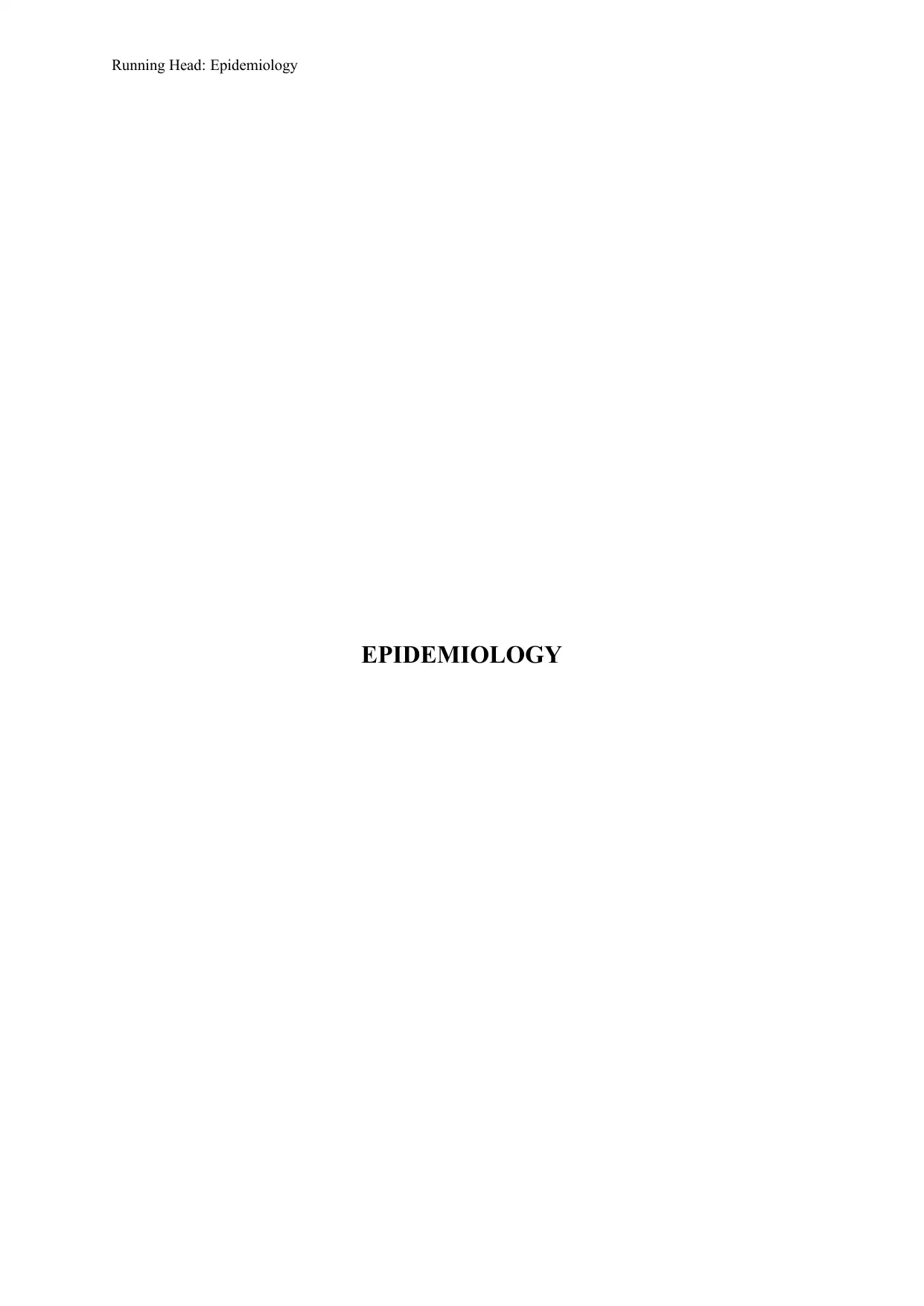
Running Head: Epidemiology
EPIDEMIOLOGY
EPIDEMIOLOGY
Paraphrase This Document
Need a fresh take? Get an instant paraphrase of this document with our AI Paraphraser
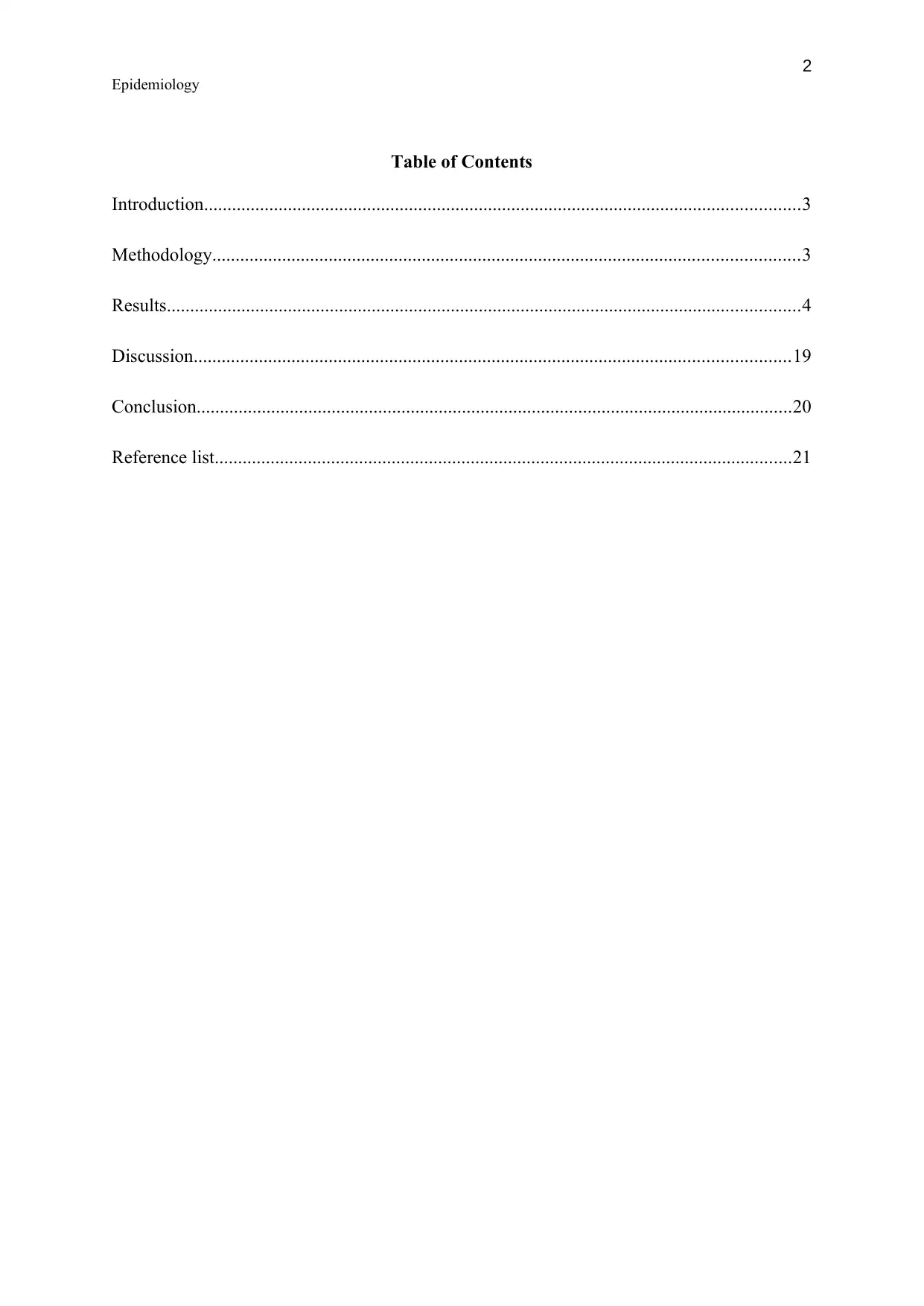
2
Epidemiology
Table of Contents
Introduction................................................................................................................................3
Methodology..............................................................................................................................3
Results........................................................................................................................................4
Discussion................................................................................................................................19
Conclusion................................................................................................................................20
Reference list............................................................................................................................21
Epidemiology
Table of Contents
Introduction................................................................................................................................3
Methodology..............................................................................................................................3
Results........................................................................................................................................4
Discussion................................................................................................................................19
Conclusion................................................................................................................................20
Reference list............................................................................................................................21
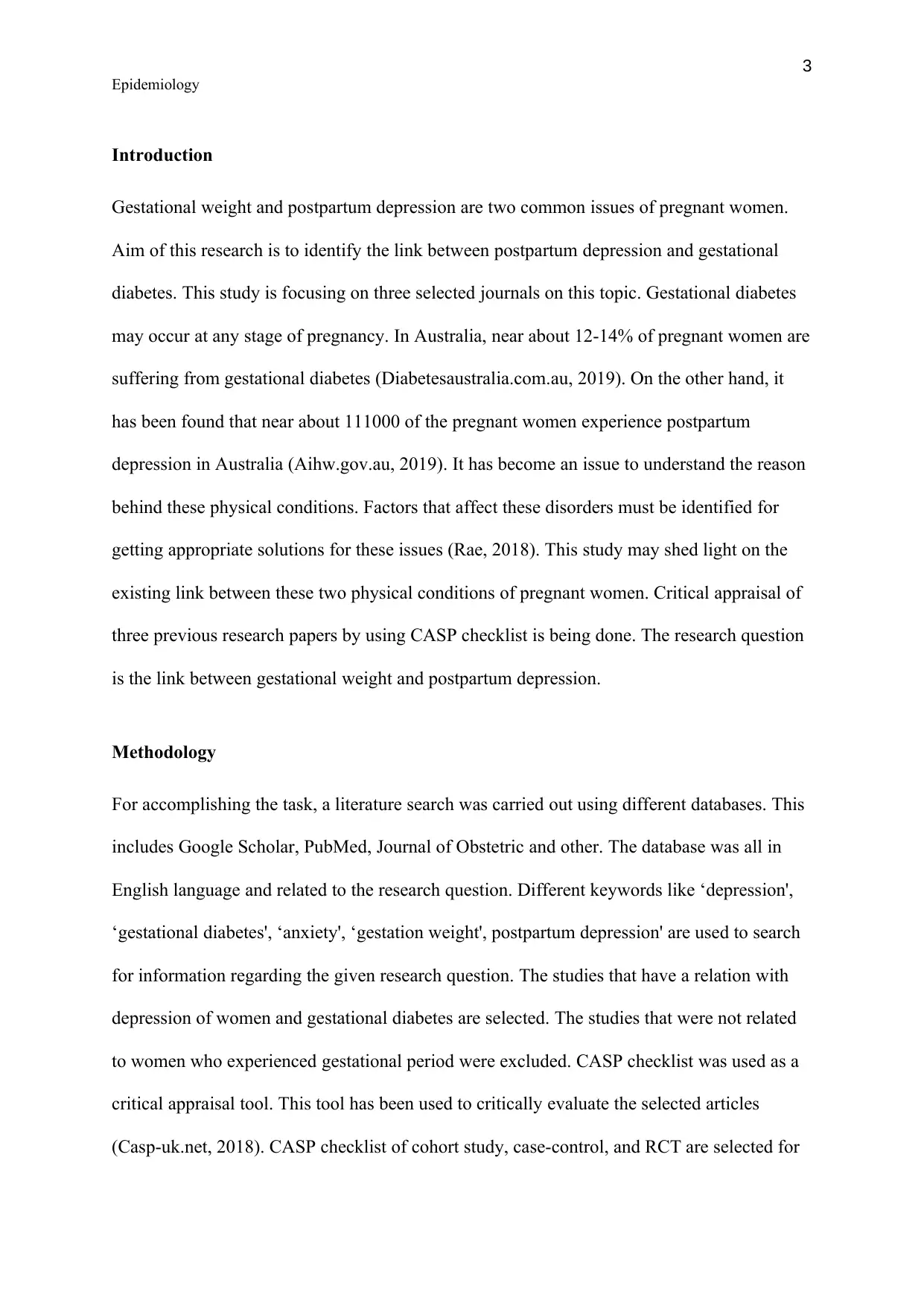
3
Epidemiology
Introduction
Gestational weight and postpartum depression are two common issues of pregnant women.
Aim of this research is to identify the link between postpartum depression and gestational
diabetes. This study is focusing on three selected journals on this topic. Gestational diabetes
may occur at any stage of pregnancy. In Australia, near about 12-14% of pregnant women are
suffering from gestational diabetes (Diabetesaustralia.com.au, 2019). On the other hand, it
has been found that near about 111000 of the pregnant women experience postpartum
depression in Australia (Aihw.gov.au, 2019). It has become an issue to understand the reason
behind these physical conditions. Factors that affect these disorders must be identified for
getting appropriate solutions for these issues (Rae, 2018). This study may shed light on the
existing link between these two physical conditions of pregnant women. Critical appraisal of
three previous research papers by using CASP checklist is being done. The research question
is the link between gestational weight and postpartum depression.
Methodology
For accomplishing the task, a literature search was carried out using different databases. This
includes Google Scholar, PubMed, Journal of Obstetric and other. The database was all in
English language and related to the research question. Different keywords like ‘depression',
‘gestational diabetes', ‘anxiety', ‘gestation weight', postpartum depression' are used to search
for information regarding the given research question. The studies that have a relation with
depression of women and gestational diabetes are selected. The studies that were not related
to women who experienced gestational period were excluded. CASP checklist was used as a
critical appraisal tool. This tool has been used to critically evaluate the selected articles
(Casp-uk.net, 2018). CASP checklist of cohort study, case-control, and RCT are selected for
Epidemiology
Introduction
Gestational weight and postpartum depression are two common issues of pregnant women.
Aim of this research is to identify the link between postpartum depression and gestational
diabetes. This study is focusing on three selected journals on this topic. Gestational diabetes
may occur at any stage of pregnancy. In Australia, near about 12-14% of pregnant women are
suffering from gestational diabetes (Diabetesaustralia.com.au, 2019). On the other hand, it
has been found that near about 111000 of the pregnant women experience postpartum
depression in Australia (Aihw.gov.au, 2019). It has become an issue to understand the reason
behind these physical conditions. Factors that affect these disorders must be identified for
getting appropriate solutions for these issues (Rae, 2018). This study may shed light on the
existing link between these two physical conditions of pregnant women. Critical appraisal of
three previous research papers by using CASP checklist is being done. The research question
is the link between gestational weight and postpartum depression.
Methodology
For accomplishing the task, a literature search was carried out using different databases. This
includes Google Scholar, PubMed, Journal of Obstetric and other. The database was all in
English language and related to the research question. Different keywords like ‘depression',
‘gestational diabetes', ‘anxiety', ‘gestation weight', postpartum depression' are used to search
for information regarding the given research question. The studies that have a relation with
depression of women and gestational diabetes are selected. The studies that were not related
to women who experienced gestational period were excluded. CASP checklist was used as a
critical appraisal tool. This tool has been used to critically evaluate the selected articles
(Casp-uk.net, 2018). CASP checklist of cohort study, case-control, and RCT are selected for
⊘ This is a preview!⊘
Do you want full access?
Subscribe today to unlock all pages.

Trusted by 1+ million students worldwide
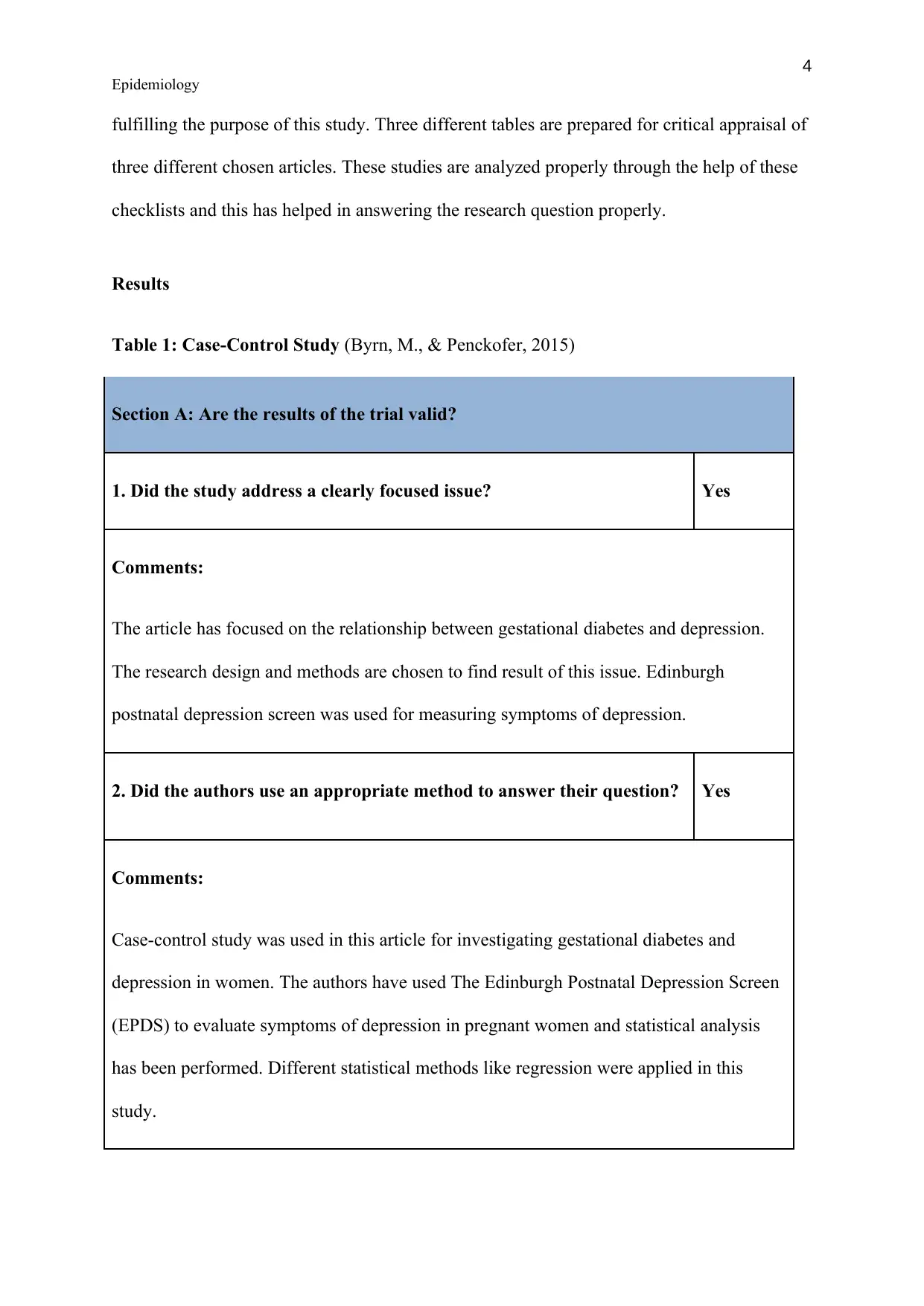
4
Epidemiology
fulfilling the purpose of this study. Three different tables are prepared for critical appraisal of
three different chosen articles. These studies are analyzed properly through the help of these
checklists and this has helped in answering the research question properly.
Results
Table 1: Case-Control Study (Byrn, M., & Penckofer, 2015)
Section A: Are the results of the trial valid?
1. Did the study address a clearly focused issue? Yes
Comments:
The article has focused on the relationship between gestational diabetes and depression.
The research design and methods are chosen to find result of this issue. Edinburgh
postnatal depression screen was used for measuring symptoms of depression.
2. Did the authors use an appropriate method to answer their question? Yes
Comments:
Case-control study was used in this article for investigating gestational diabetes and
depression in women. The authors have used The Edinburgh Postnatal Depression Screen
(EPDS) to evaluate symptoms of depression in pregnant women and statistical analysis
has been performed. Different statistical methods like regression were applied in this
study.
Epidemiology
fulfilling the purpose of this study. Three different tables are prepared for critical appraisal of
three different chosen articles. These studies are analyzed properly through the help of these
checklists and this has helped in answering the research question properly.
Results
Table 1: Case-Control Study (Byrn, M., & Penckofer, 2015)
Section A: Are the results of the trial valid?
1. Did the study address a clearly focused issue? Yes
Comments:
The article has focused on the relationship between gestational diabetes and depression.
The research design and methods are chosen to find result of this issue. Edinburgh
postnatal depression screen was used for measuring symptoms of depression.
2. Did the authors use an appropriate method to answer their question? Yes
Comments:
Case-control study was used in this article for investigating gestational diabetes and
depression in women. The authors have used The Edinburgh Postnatal Depression Screen
(EPDS) to evaluate symptoms of depression in pregnant women and statistical analysis
has been performed. Different statistical methods like regression were applied in this
study.
Paraphrase This Document
Need a fresh take? Get an instant paraphrase of this document with our AI Paraphraser
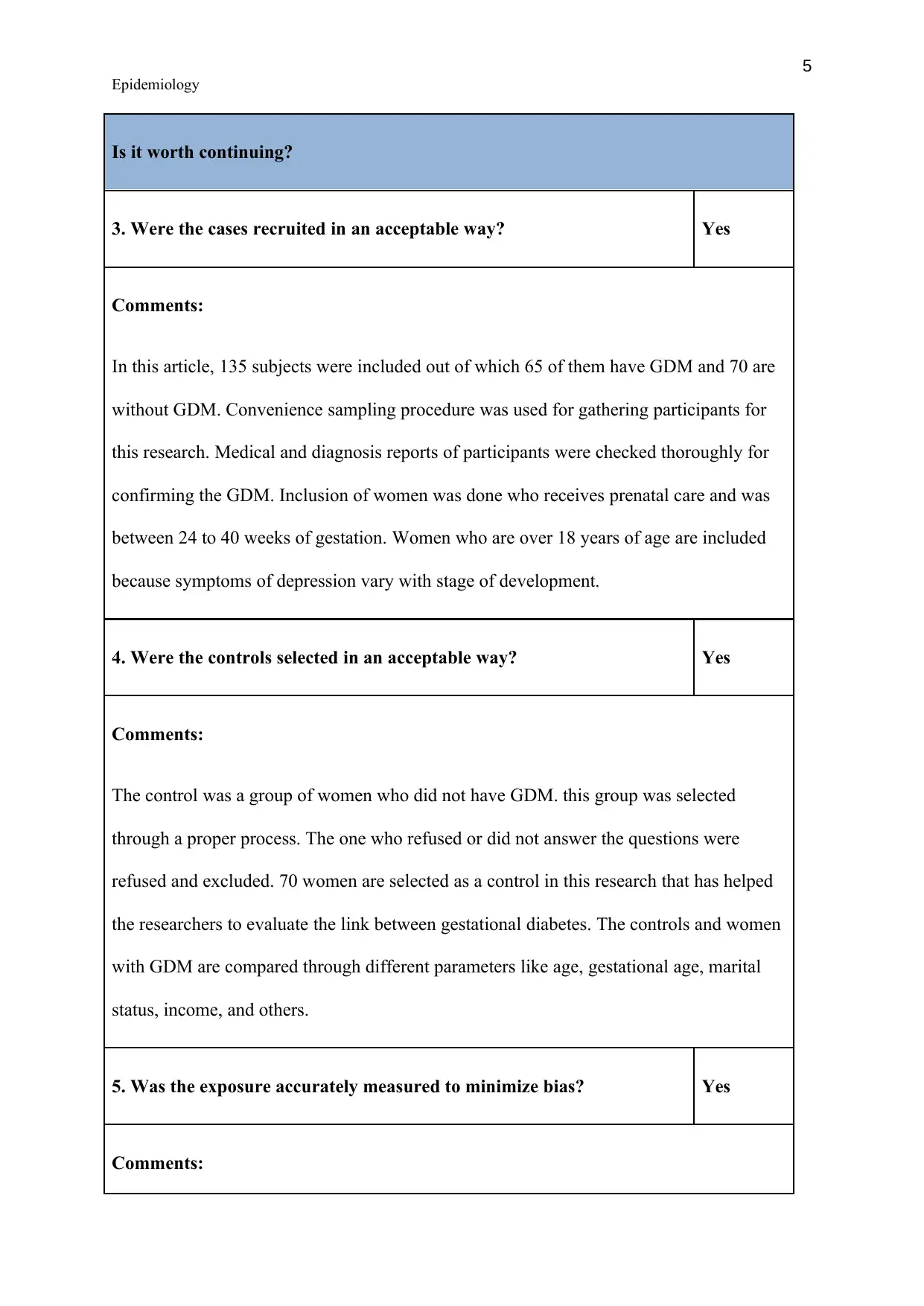
5
Epidemiology
Is it worth continuing?
3. Were the cases recruited in an acceptable way? Yes
Comments:
In this article, 135 subjects were included out of which 65 of them have GDM and 70 are
without GDM. Convenience sampling procedure was used for gathering participants for
this research. Medical and diagnosis reports of participants were checked thoroughly for
confirming the GDM. Inclusion of women was done who receives prenatal care and was
between 24 to 40 weeks of gestation. Women who are over 18 years of age are included
because symptoms of depression vary with stage of development.
4. Were the controls selected in an acceptable way? Yes
Comments:
The control was a group of women who did not have GDM. this group was selected
through a proper process. The one who refused or did not answer the questions were
refused and excluded. 70 women are selected as a control in this research that has helped
the researchers to evaluate the link between gestational diabetes. The controls and women
with GDM are compared through different parameters like age, gestational age, marital
status, income, and others.
5. Was the exposure accurately measured to minimize bias? Yes
Comments:
Epidemiology
Is it worth continuing?
3. Were the cases recruited in an acceptable way? Yes
Comments:
In this article, 135 subjects were included out of which 65 of them have GDM and 70 are
without GDM. Convenience sampling procedure was used for gathering participants for
this research. Medical and diagnosis reports of participants were checked thoroughly for
confirming the GDM. Inclusion of women was done who receives prenatal care and was
between 24 to 40 weeks of gestation. Women who are over 18 years of age are included
because symptoms of depression vary with stage of development.
4. Were the controls selected in an acceptable way? Yes
Comments:
The control was a group of women who did not have GDM. this group was selected
through a proper process. The one who refused or did not answer the questions were
refused and excluded. 70 women are selected as a control in this research that has helped
the researchers to evaluate the link between gestational diabetes. The controls and women
with GDM are compared through different parameters like age, gestational age, marital
status, income, and others.
5. Was the exposure accurately measured to minimize bias? Yes
Comments:
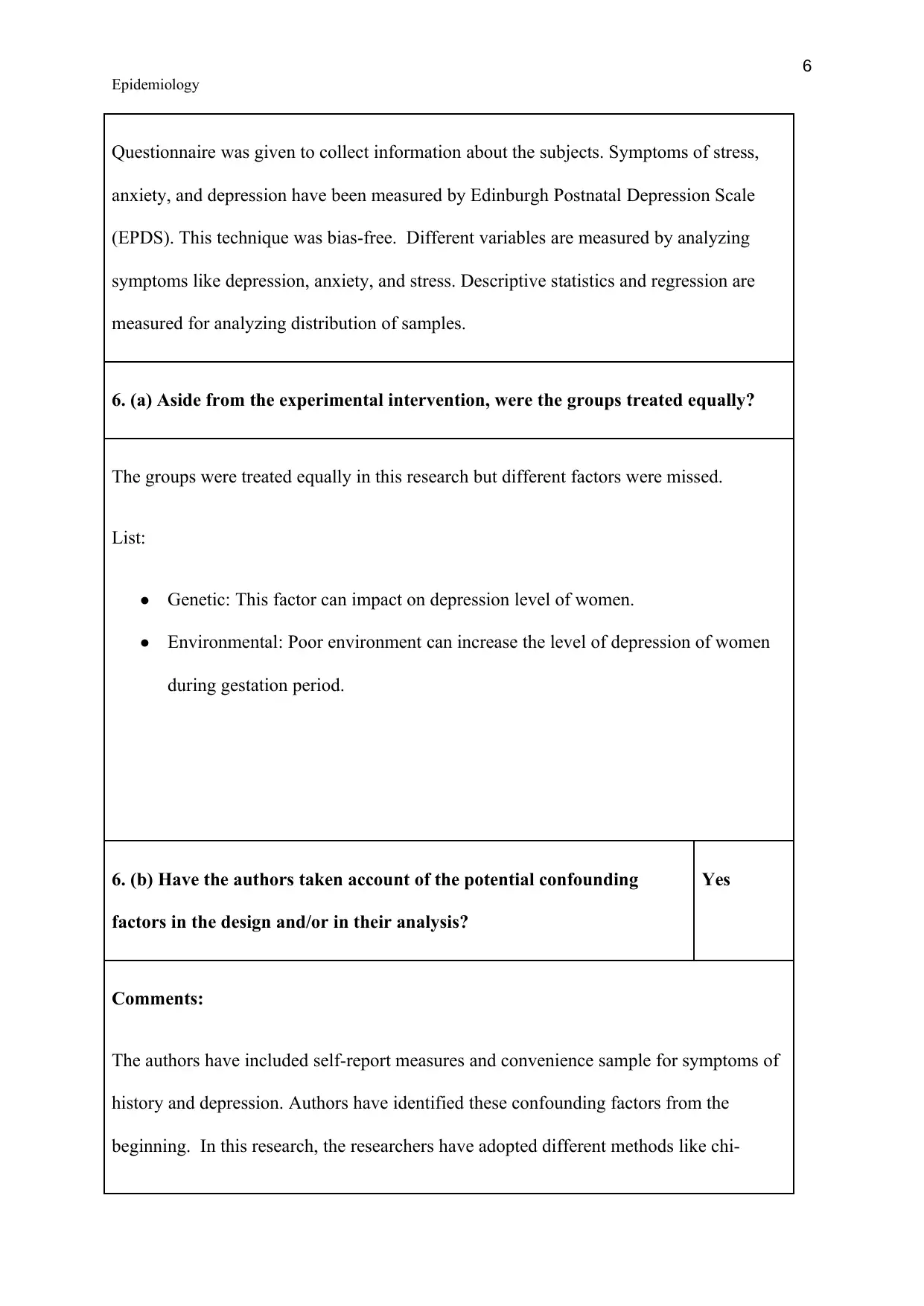
6
Epidemiology
Questionnaire was given to collect information about the subjects. Symptoms of stress,
anxiety, and depression have been measured by Edinburgh Postnatal Depression Scale
(EPDS). This technique was bias-free. Different variables are measured by analyzing
symptoms like depression, anxiety, and stress. Descriptive statistics and regression are
measured for analyzing distribution of samples.
6. (a) Aside from the experimental intervention, were the groups treated equally?
The groups were treated equally in this research but different factors were missed.
List:
● Genetic: This factor can impact on depression level of women.
● Environmental: Poor environment can increase the level of depression of women
during gestation period.
6. (b) Have the authors taken account of the potential confounding
factors in the design and/or in their analysis?
Yes
Comments:
The authors have included self-report measures and convenience sample for symptoms of
history and depression. Authors have identified these confounding factors from the
beginning. In this research, the researchers have adopted different methods like chi-
Epidemiology
Questionnaire was given to collect information about the subjects. Symptoms of stress,
anxiety, and depression have been measured by Edinburgh Postnatal Depression Scale
(EPDS). This technique was bias-free. Different variables are measured by analyzing
symptoms like depression, anxiety, and stress. Descriptive statistics and regression are
measured for analyzing distribution of samples.
6. (a) Aside from the experimental intervention, were the groups treated equally?
The groups were treated equally in this research but different factors were missed.
List:
● Genetic: This factor can impact on depression level of women.
● Environmental: Poor environment can increase the level of depression of women
during gestation period.
6. (b) Have the authors taken account of the potential confounding
factors in the design and/or in their analysis?
Yes
Comments:
The authors have included self-report measures and convenience sample for symptoms of
history and depression. Authors have identified these confounding factors from the
beginning. In this research, the researchers have adopted different methods like chi-
⊘ This is a preview!⊘
Do you want full access?
Subscribe today to unlock all pages.

Trusted by 1+ million students worldwide
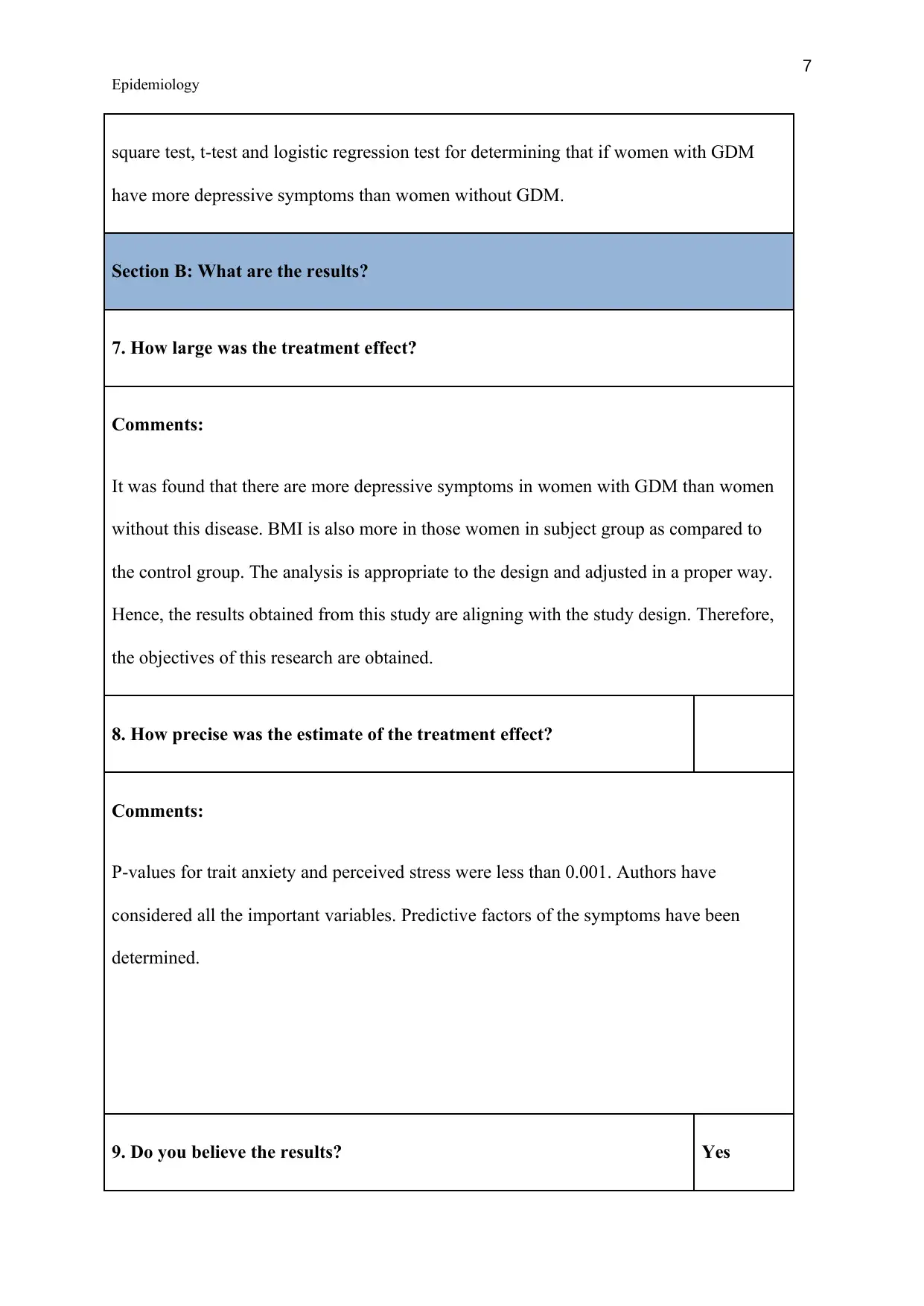
7
Epidemiology
square test, t-test and logistic regression test for determining that if women with GDM
have more depressive symptoms than women without GDM.
Section B: What are the results?
7. How large was the treatment effect?
Comments:
It was found that there are more depressive symptoms in women with GDM than women
without this disease. BMI is also more in those women in subject group as compared to
the control group. The analysis is appropriate to the design and adjusted in a proper way.
Hence, the results obtained from this study are aligning with the study design. Therefore,
the objectives of this research are obtained.
8. How precise was the estimate of the treatment effect?
Comments:
P-values for trait anxiety and perceived stress were less than 0.001. Authors have
considered all the important variables. Predictive factors of the symptoms have been
determined.
9. Do you believe the results? Yes
Epidemiology
square test, t-test and logistic regression test for determining that if women with GDM
have more depressive symptoms than women without GDM.
Section B: What are the results?
7. How large was the treatment effect?
Comments:
It was found that there are more depressive symptoms in women with GDM than women
without this disease. BMI is also more in those women in subject group as compared to
the control group. The analysis is appropriate to the design and adjusted in a proper way.
Hence, the results obtained from this study are aligning with the study design. Therefore,
the objectives of this research are obtained.
8. How precise was the estimate of the treatment effect?
Comments:
P-values for trait anxiety and perceived stress were less than 0.001. Authors have
considered all the important variables. Predictive factors of the symptoms have been
determined.
9. Do you believe the results? Yes
Paraphrase This Document
Need a fresh take? Get an instant paraphrase of this document with our AI Paraphraser
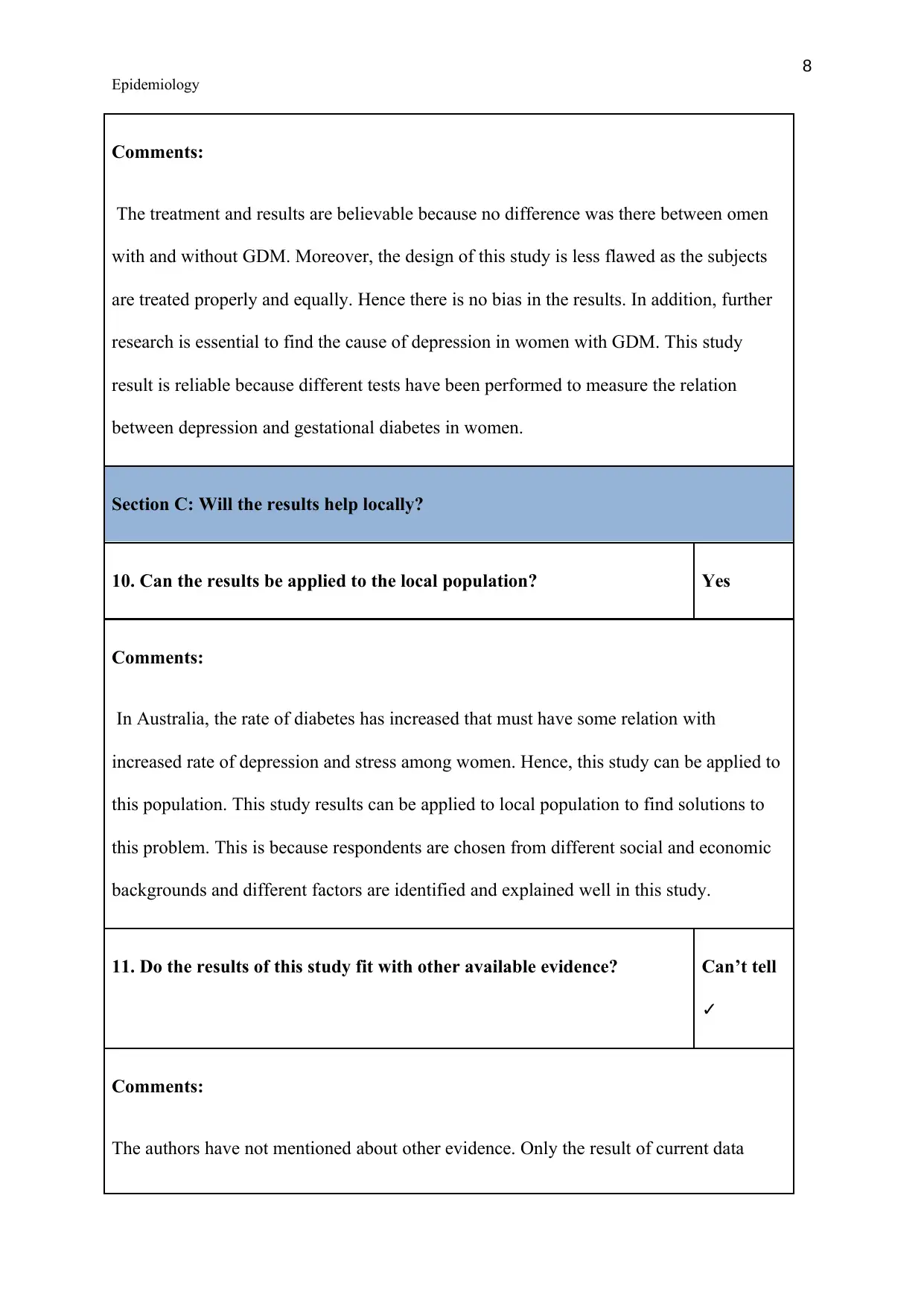
8
Epidemiology
Comments:
The treatment and results are believable because no difference was there between omen
with and without GDM. Moreover, the design of this study is less flawed as the subjects
are treated properly and equally. Hence there is no bias in the results. In addition, further
research is essential to find the cause of depression in women with GDM. This study
result is reliable because different tests have been performed to measure the relation
between depression and gestational diabetes in women.
Section C: Will the results help locally?
10. Can the results be applied to the local population? Yes
Comments:
In Australia, the rate of diabetes has increased that must have some relation with
increased rate of depression and stress among women. Hence, this study can be applied to
this population. This study results can be applied to local population to find solutions to
this problem. This is because respondents are chosen from different social and economic
backgrounds and different factors are identified and explained well in this study.
11. Do the results of this study fit with other available evidence? Can’t tell
✓
Comments:
The authors have not mentioned about other evidence. Only the result of current data
Epidemiology
Comments:
The treatment and results are believable because no difference was there between omen
with and without GDM. Moreover, the design of this study is less flawed as the subjects
are treated properly and equally. Hence there is no bias in the results. In addition, further
research is essential to find the cause of depression in women with GDM. This study
result is reliable because different tests have been performed to measure the relation
between depression and gestational diabetes in women.
Section C: Will the results help locally?
10. Can the results be applied to the local population? Yes
Comments:
In Australia, the rate of diabetes has increased that must have some relation with
increased rate of depression and stress among women. Hence, this study can be applied to
this population. This study results can be applied to local population to find solutions to
this problem. This is because respondents are chosen from different social and economic
backgrounds and different factors are identified and explained well in this study.
11. Do the results of this study fit with other available evidence? Can’t tell
✓
Comments:
The authors have not mentioned about other evidence. Only the result of current data

9
Epidemiology
analysis has been considered for getting the final result.
Epidemiology
analysis has been considered for getting the final result.
⊘ This is a preview!⊘
Do you want full access?
Subscribe today to unlock all pages.

Trusted by 1+ million students worldwide
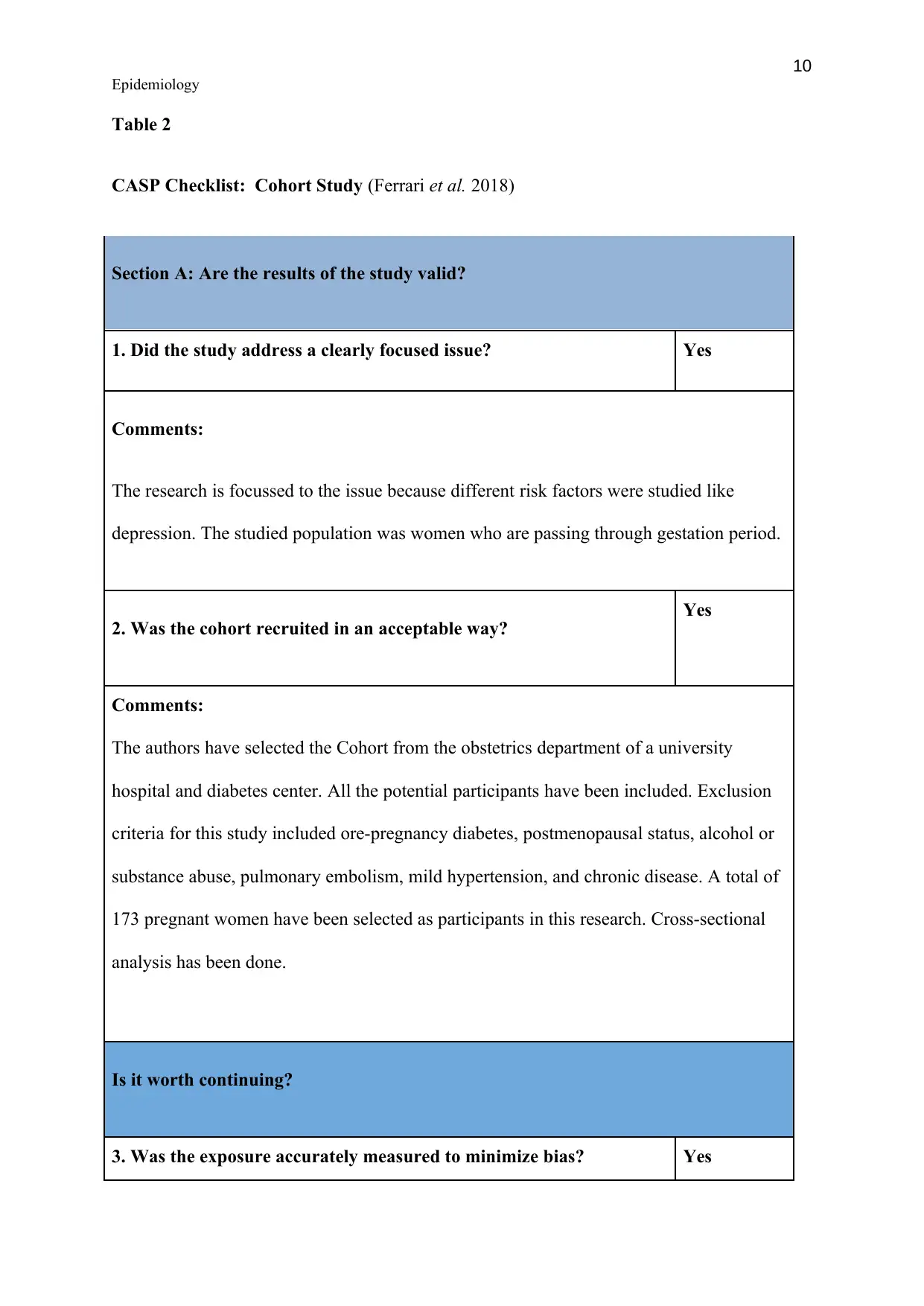
10
Epidemiology
Table 2
CASP Checklist: Cohort Study (Ferrari et al. 2018)
Section A: Are the results of the study valid?
1. Did the study address a clearly focused issue? Yes
Comments:
The research is focussed to the issue because different risk factors were studied like
depression. The studied population was women who are passing through gestation period.
2. Was the cohort recruited in an acceptable way? Yes
Comments:
The authors have selected the Cohort from the obstetrics department of a university
hospital and diabetes center. All the potential participants have been included. Exclusion
criteria for this study included ore-pregnancy diabetes, postmenopausal status, alcohol or
substance abuse, pulmonary embolism, mild hypertension, and chronic disease. A total of
173 pregnant women have been selected as participants in this research. Cross-sectional
analysis has been done.
Is it worth continuing?
3. Was the exposure accurately measured to minimize bias? Yes
Epidemiology
Table 2
CASP Checklist: Cohort Study (Ferrari et al. 2018)
Section A: Are the results of the study valid?
1. Did the study address a clearly focused issue? Yes
Comments:
The research is focussed to the issue because different risk factors were studied like
depression. The studied population was women who are passing through gestation period.
2. Was the cohort recruited in an acceptable way? Yes
Comments:
The authors have selected the Cohort from the obstetrics department of a university
hospital and diabetes center. All the potential participants have been included. Exclusion
criteria for this study included ore-pregnancy diabetes, postmenopausal status, alcohol or
substance abuse, pulmonary embolism, mild hypertension, and chronic disease. A total of
173 pregnant women have been selected as participants in this research. Cross-sectional
analysis has been done.
Is it worth continuing?
3. Was the exposure accurately measured to minimize bias? Yes
Paraphrase This Document
Need a fresh take? Get an instant paraphrase of this document with our AI Paraphraser
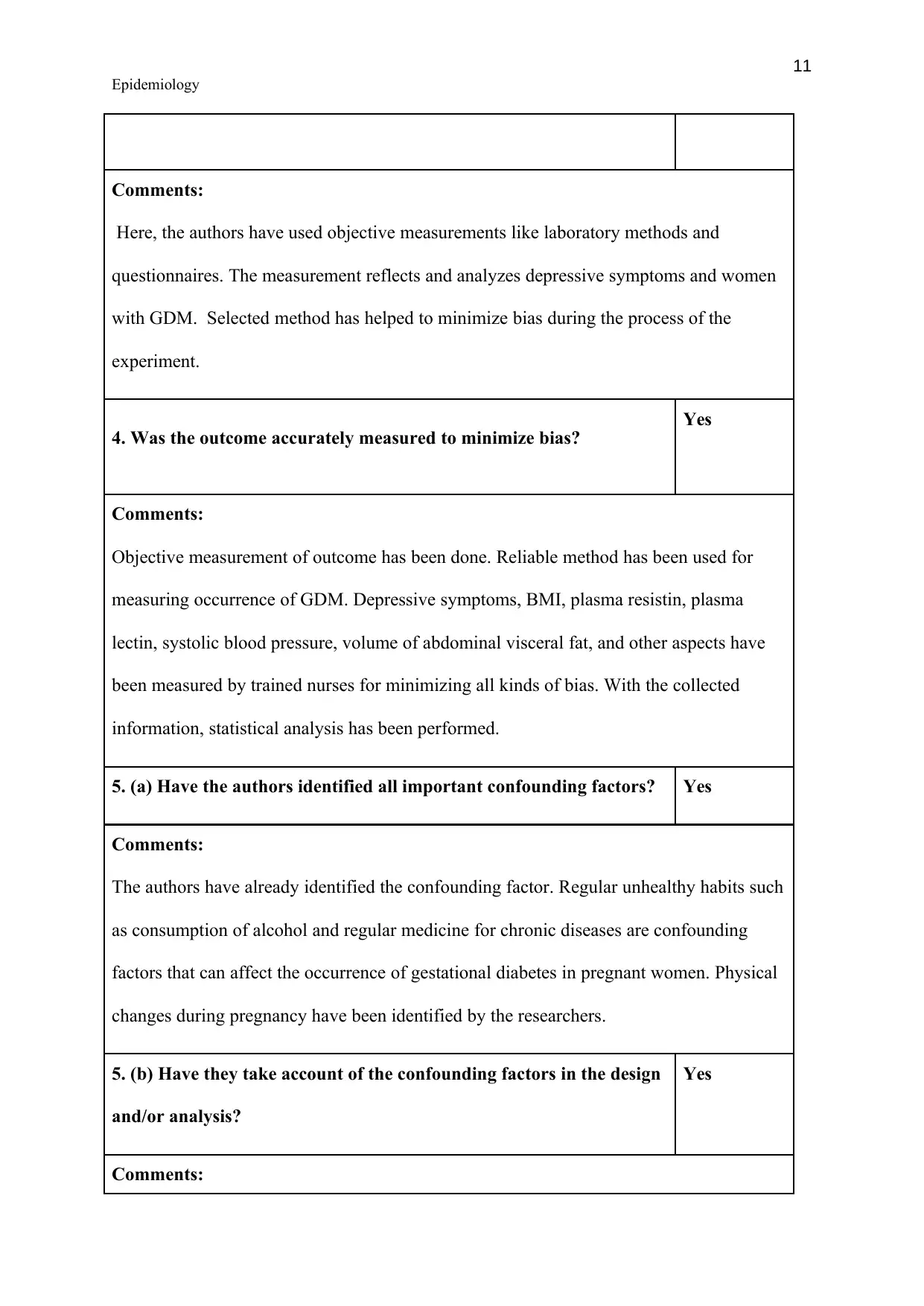
11
Epidemiology
Comments:
Here, the authors have used objective measurements like laboratory methods and
questionnaires. The measurement reflects and analyzes depressive symptoms and women
with GDM. Selected method has helped to minimize bias during the process of the
experiment.
4. Was the outcome accurately measured to minimize bias? Yes
Comments:
Objective measurement of outcome has been done. Reliable method has been used for
measuring occurrence of GDM. Depressive symptoms, BMI, plasma resistin, plasma
lectin, systolic blood pressure, volume of abdominal visceral fat, and other aspects have
been measured by trained nurses for minimizing all kinds of bias. With the collected
information, statistical analysis has been performed.
5. (a) Have the authors identified all important confounding factors? Yes
Comments:
The authors have already identified the confounding factor. Regular unhealthy habits such
as consumption of alcohol and regular medicine for chronic diseases are confounding
factors that can affect the occurrence of gestational diabetes in pregnant women. Physical
changes during pregnancy have been identified by the researchers.
5. (b) Have they take account of the confounding factors in the design
and/or analysis?
Yes
Comments:
Epidemiology
Comments:
Here, the authors have used objective measurements like laboratory methods and
questionnaires. The measurement reflects and analyzes depressive symptoms and women
with GDM. Selected method has helped to minimize bias during the process of the
experiment.
4. Was the outcome accurately measured to minimize bias? Yes
Comments:
Objective measurement of outcome has been done. Reliable method has been used for
measuring occurrence of GDM. Depressive symptoms, BMI, plasma resistin, plasma
lectin, systolic blood pressure, volume of abdominal visceral fat, and other aspects have
been measured by trained nurses for minimizing all kinds of bias. With the collected
information, statistical analysis has been performed.
5. (a) Have the authors identified all important confounding factors? Yes
Comments:
The authors have already identified the confounding factor. Regular unhealthy habits such
as consumption of alcohol and regular medicine for chronic diseases are confounding
factors that can affect the occurrence of gestational diabetes in pregnant women. Physical
changes during pregnancy have been identified by the researchers.
5. (b) Have they take account of the confounding factors in the design
and/or analysis?
Yes
Comments:
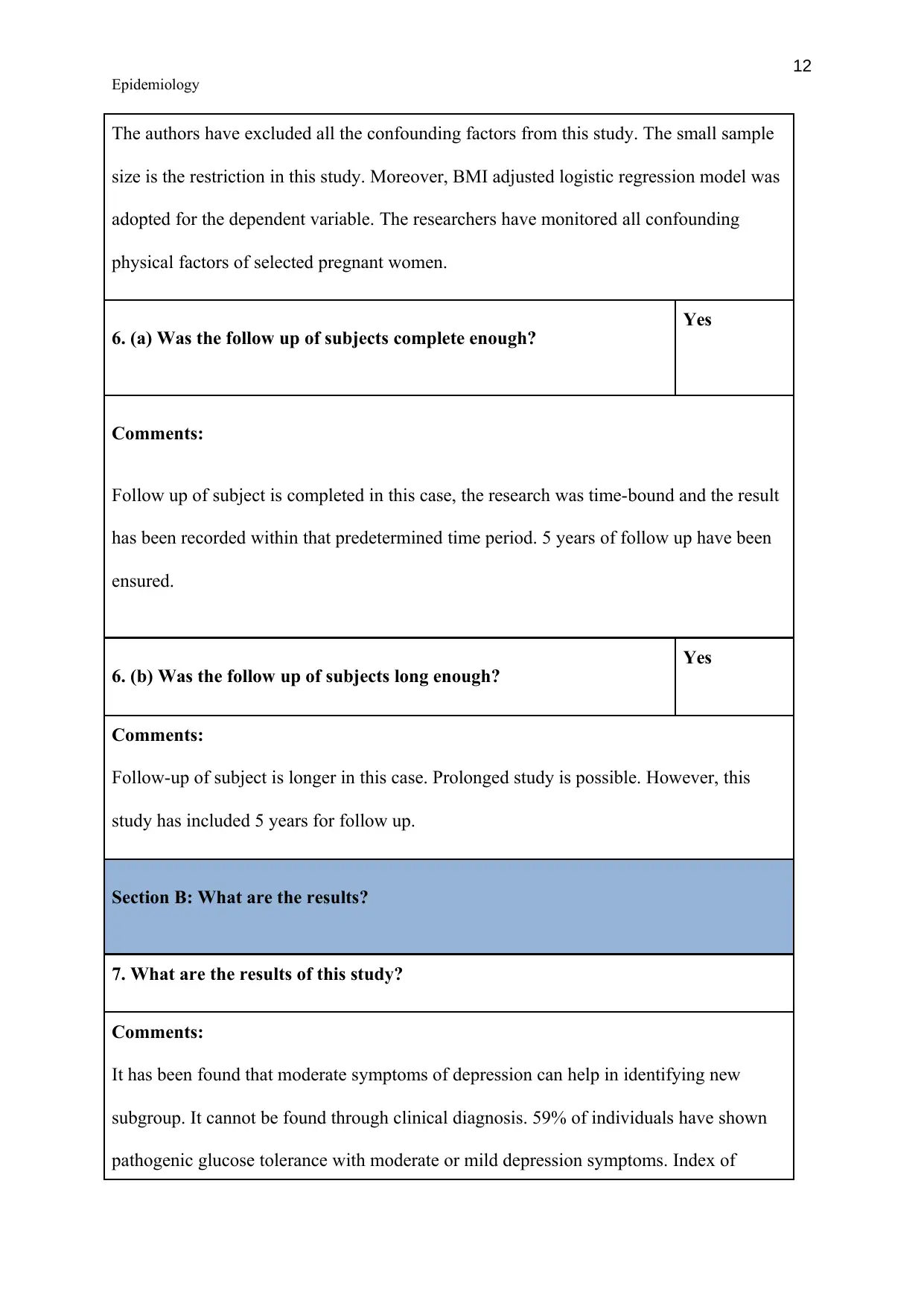
12
Epidemiology
The authors have excluded all the confounding factors from this study. The small sample
size is the restriction in this study. Moreover, BMI adjusted logistic regression model was
adopted for the dependent variable. The researchers have monitored all confounding
physical factors of selected pregnant women.
6. (a) Was the follow up of subjects complete enough? Yes
Comments:
Follow up of subject is completed in this case, the research was time-bound and the result
has been recorded within that predetermined time period. 5 years of follow up have been
ensured.
6. (b) Was the follow up of subjects long enough? Yes
Comments:
Follow-up of subject is longer in this case. Prolonged study is possible. However, this
study has included 5 years for follow up.
Section B: What are the results?
7. What are the results of this study?
Comments:
It has been found that moderate symptoms of depression can help in identifying new
subgroup. It cannot be found through clinical diagnosis. 59% of individuals have shown
pathogenic glucose tolerance with moderate or mild depression symptoms. Index of
Epidemiology
The authors have excluded all the confounding factors from this study. The small sample
size is the restriction in this study. Moreover, BMI adjusted logistic regression model was
adopted for the dependent variable. The researchers have monitored all confounding
physical factors of selected pregnant women.
6. (a) Was the follow up of subjects complete enough? Yes
Comments:
Follow up of subject is completed in this case, the research was time-bound and the result
has been recorded within that predetermined time period. 5 years of follow up have been
ensured.
6. (b) Was the follow up of subjects long enough? Yes
Comments:
Follow-up of subject is longer in this case. Prolonged study is possible. However, this
study has included 5 years for follow up.
Section B: What are the results?
7. What are the results of this study?
Comments:
It has been found that moderate symptoms of depression can help in identifying new
subgroup. It cannot be found through clinical diagnosis. 59% of individuals have shown
pathogenic glucose tolerance with moderate or mild depression symptoms. Index of
⊘ This is a preview!⊘
Do you want full access?
Subscribe today to unlock all pages.

Trusted by 1+ million students worldwide
1 out of 22
Related Documents
Your All-in-One AI-Powered Toolkit for Academic Success.
+13062052269
info@desklib.com
Available 24*7 on WhatsApp / Email
![[object Object]](/_next/static/media/star-bottom.7253800d.svg)
Unlock your academic potential
Copyright © 2020–2025 A2Z Services. All Rights Reserved. Developed and managed by ZUCOL.





